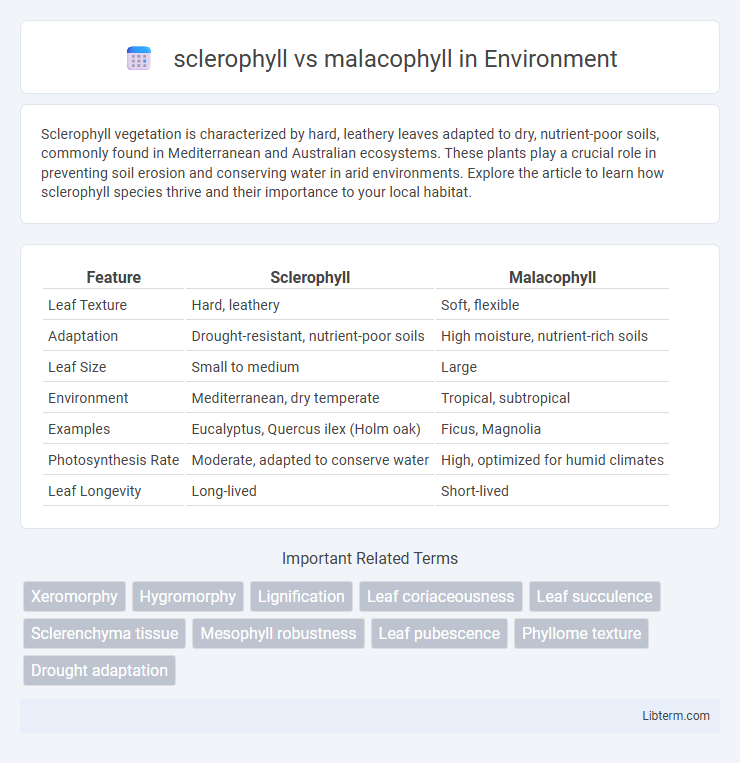Sclerophyll vegetation is characterized by hard, leathery leaves adapted to dry, nutrient-poor soils, commonly found in Mediterranean and Australian ecosystems. These plants play a crucial role in preventing soil erosion and conserving water in arid environments. Explore the article to learn how sclerophyll species thrive and their importance to your local habitat.
Table of Comparison
| Feature | Sclerophyll | Malacophyll |
|---|---|---|
| Leaf Texture | Hard, leathery | Soft, flexible |
| Adaptation | Drought-resistant, nutrient-poor soils | High moisture, nutrient-rich soils |
| Leaf Size | Small to medium | Large |
| Environment | Mediterranean, dry temperate | Tropical, subtropical |
| Examples | Eucalyptus, Quercus ilex (Holm oak) | Ficus, Magnolia |
| Photosynthesis Rate | Moderate, adapted to conserve water | High, optimized for humid climates |
| Leaf Longevity | Long-lived | Short-lived |
Introduction to Sclerophyll and Malacophyll Plants
Sclerophyll plants possess hard, thick leaves adapted to dry and nutrient-poor environments, featuring a high density of sclerenchyma cells that enhance durability and reduce water loss. Malacophyll plants, in contrast, have soft, broad leaves with a higher surface area that support efficient photosynthesis in moist, nutrient-rich habitats. These distinct leaf structures reflect adaptive strategies that optimize survival in varying ecological conditions.
Defining Sclerophyll: Characteristics and Adaptations
Sclerophyll plants are characterized by their hard, thick, and leathery leaves that minimize water loss and withstand drought conditions, commonly found in Mediterranean and Australian climates. These adaptations include a dense cuticle, sunken stomata, and a high concentration of lignin and cellulose, enabling efficient water conservation and protection against herbivory. Compared to malacophyll plants, which have softer, thinner leaves suited to moist environments, sclerophyll foliage is specifically evolved for arid and nutrient-poor soils.
Understanding Malacophyll: Features and Growth Habits
Malacophyll leaves are characterized by their large, soft, and broad structures, which allow efficient photosynthesis and water retention in humid, nutrient-rich environments. These leaves typically exhibit thin cuticles and abundant stomata, supporting rapid gas exchange and growth in shaded or moist habitats. Understanding malacophyll growth habits aids in ecological studies, as these plants often dominate in tropical and subtropical forests where water availability and light are not limiting factors.
Key Differences Between Sclerophyll and Malacophyll
Sclerophyll leaves are characterized by thick, tough, and leathery textures with a high lignin content, adapted to reduce water loss in dry, nutrient-poor environments, while malacophyll leaves are soft, broad, and less rigid, commonly found in humid, nutrient-rich habitats. Sclerophyllous vegetation typically exhibits small leaf size with a dense cuticle and sunken stomata to minimize transpiration, whereas malacophyll leaves have larger surface areas and thinner cuticles facilitating efficient gas exchange and photosynthesis. The difference in anatomical structure profoundly affects physiological functions, with sclerophylls demonstrating enhanced drought tolerance and slower growth rates compared to the faster-growing, moisture-dependent malacophylls.
Leaf Structure Comparison: Toughness vs Softness
Sclerophyll leaves exhibit a tough, rigid structure characterized by thick, waxy cuticles and dense fiber bundles, enabling resistance to water loss and herbivory. Malacophyll leaves are soft with thinner cuticles and less lignified tissues, allowing higher flexibility and increased surface area for photosynthesis in moist environments. This contrast in leaf structure reflects adaptation strategies to differing ecological conditions, with sclerophyll favoring drought-prone habitats and malacophyll thriving in humid regions.
Environmental Adaptations and Habitats
Sclerophyll plants possess thick, tough leaves with a high lignin content, adapted to arid, nutrient-poor environments such as Mediterranean climates and eucalyptus forests, enabling efficient water conservation and resistance to herbivory. Malacophyll plants feature large, soft leaves with thinner cuticles, thriving in moist, nutrient-rich habitats like tropical rainforests, where ample water availability reduces the need for protective leaf structures. The distinct leaf morphologies reflect evolutionary adaptations to optimize survival under varying environmental stresses including water scarcity and soil fertility.
Evolutionary Significance of Sclerophyll and Malacophyll
Sclerophyll leaves, characterized by thick, leathery texture and high lignin content, evolved as an adaptive response to nutrient-poor soils and arid conditions, enhancing water conservation and resistance to herbivory. Malacophyll leaves, with their softer, thinner structure and higher nutrient content, represent adaptations to environments with abundant water and nutrient availability, promoting rapid growth and efficient photosynthesis. The evolutionary divergence between sclerophyll and malacophyll reflects distinct ecological strategies for survival, influencing plant distribution and ecosystem dynamics in varying climatic and soil conditions.
Examples of Sclerophyllous and Malacophyllous Species
Eucalyptus and Acacia are prominent examples of sclerophyllous species, characterized by their tough, leathery leaves adapted to dry, nutrient-poor soils. In contrast, species such as Magnolia and Banana represent malacophyllous plants, featuring broad, soft leaves suited for moist, nutrient-rich environments. These adaptations reflect their ecological niches, with sclerophyllous plants thriving in arid conditions and malacophyllous plants favoring humid, fertile habitats.
Ecological Roles in Their Respective Ecosystems
Sclerophyll plants feature hard, leathery leaves adapted to dry, nutrient-poor environments, playing a crucial role in water conservation and supporting fire-adapted ecosystems like Australian bushlands. Malacophyll plants possess soft, broad leaves optimized for efficient photosynthesis in moist, nutrient-rich habitats, contributing to dense forest canopies and higher biodiversity in tropical and subtropical regions. These distinct leaf morphologies influence soil nutrient cycling, habitat structure, and overall ecosystem productivity in their respective ecological niches.
Choosing Sclerophyll or Malacophyll Plants for Landscaping
Sclerophyll plants, characterized by their tough, leathery leaves, are ideal for drought-prone landscapes due to their high water-use efficiency and resistance to heat stress. Malacophyll plants feature softer, larger leaves and thrive in moist environments, making them suitable for shaded or irrigated garden areas. Selecting between sclerophyll and malacophyll species depends on local climate, soil moisture availability, and maintenance preferences to ensure optimal plant health and landscape sustainability.
sclerophyll Infographic

 libterm.com
libterm.com